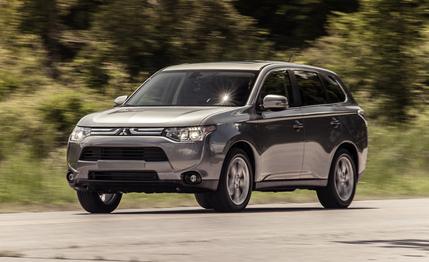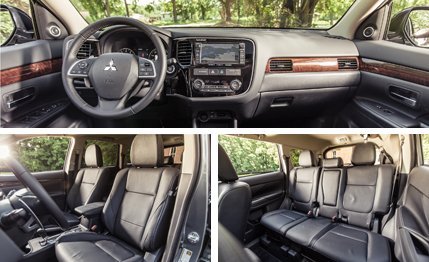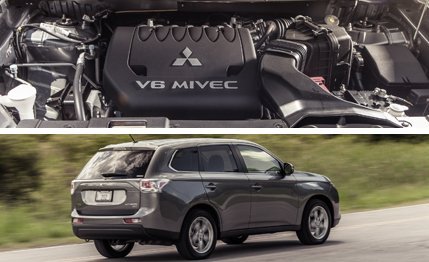
 Instrumented Test
TESTED
Instrumented Test
TESTED
Ever find yourself thumbing through an old yearbook and have one of those, “Oh, yeah, I remember that guy,” moments? That’s the feeling we experienced when the Mitsubishi Outlander GT appeared in our parking lot. Like our quirky former classmate, Mitsubishi’s automotive division once showed such great promise—hoist a Monster energy drink in tribute to the Lancer Evo—but mass success has forever escaped its grasp. As an auto manufacturer backed by the vast resources of Mitsubishi Heavy Industries, a diversified conglomerate with interests in chemical production and nuclear power—as well as oil, plastics, electronics, banking, and more—one wonders why the brand seems to stay put while the rest of the class moves onward and upward. (Read more details on Mitsu’s downward slide here.)
Aren’t You…Wait, Don’t Tell Me
Now, understand that the Outlander GT is at least putting in an effort for the 2014 model year. The exterior has been softened and smoothed, and the familial Evo-influenced fascia is gone, its distinctive large-mesh opening replaced by a modern treatment seemingly inspired by Marvin the Paranoid Android. A sharp crease forms the beltline, the bulbous wheel-arch flares have been tamed, and the abrupt corners of the rear quarter-windows have been softened. Mitsu claims to have shed some 200 pounds from the previous Outlander GT in the redesign process. That jibes with our scales. Our test vehicle weighed 3668 pounds, 192 fewer than a 2010 Outlander GT.
Although the interior also got a redo, the new, soft(er)-touch materials; the clear and concise analog white-on-black instruments; and the faux wood trim couldn’t distract us from the presence of a curious odor akin to that of a newly unpackaged vinyl shower curtain. The aroma did fade slightly over time but was exacerbated when we parked our GT in the sun—prospective shoppers might want to put their specific Outlander to the sniff test. It was easy for drivers of all shapes and sizes to find a comfortable position in the power-adjustable leather driver’s seat that came bundled with the GT Touring package, a $6100 option that includes a power glass sunroof, a power tailgate, a nav system with a seven-inch touch screen, a 710-watt Rockford Fosgate sound system with subwoofer, a lane-departure warning system, forward-collision mitigation, and adaptive cruise control.


Billed as a true seven-seater, we found the third-row seats—Mitsu says they have gained a few inches of legroom for 2014—still a hard sell, the children of one office staffer going so far to dub them the “clown seats.” The Outlander’s true competitors are all, unapologetically, five-seaters, including the Mazda CX-5, Ford Escape, and Toyota RAV4.
Same Old, Same Old
Powered by a carry-over 3.0-liter V-6 (horsepower is down by six to 224 for 2014, but the mechanicals and specs are otherwise unchanged) and six-speed automatic transmission, the lighter, leaner 2014 Outlander GT boasts improved EPA fuel-economy estimates. The highway figure climbs from 25 mpg to 28, and the city number increases from 19 mpg to 20. We pulled 22 mpg in combined driving.
In our testing, the 0-to-60 run was clocked at 7.8 seconds, a few ticks quicker than that of most of its four-cylinder rivals, but note, too, that the enabler of that time is a V-6 that exclusively drinks premium fuel. (The only way to get a four-wheel-drive Outlander with a four-cylinder engine is to opt for the Outlander S-AWC, which bundles Mitsubishi’s 2.4-liter four with a CVT. You’ll lose 58 horsepower in the deal.) Foot-to-the-floor runs kept the transmission hanging onto gears until just before the 6500-rpm redline, where the V-6 sounds particularly coarse and unrefined. Shifts come quickly and without drama, though, either automatically or called out by the large metal shift paddles.


The non-variable-boost electric power steering delivers low-effort directional changes at all speeds, which is great for parking lots but not so great for the open road. The front strut, rear multilink suspension maintains composure during mild maneuvering, but understeer grows more pronounced as cornering forces build. Although we recorded a reasonable 175-foot 70-to-0-mph braking measurement, the Outlander’s stop pedal is uncommunicative.
There’s nothing overtly wrong with the Outlander GT, but neither is there anything overtly right. Its competitors now deliver more soul-stirring and engaging dynamics, better interior quality, and more refined manners, leaving the Mitsubishi a step behind.
And what of our old high-school acquaintance? He’s making minimum wage working at a convenience store but taking some business classes at the community college. If he can get back on track, why not Mitsubishi?